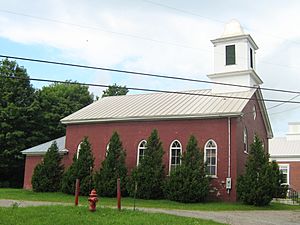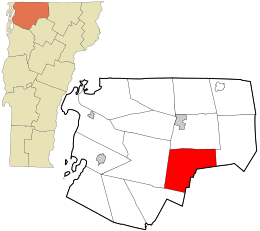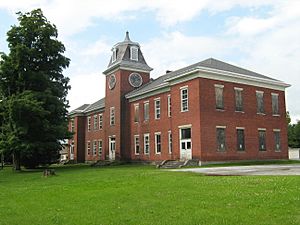Bakersfield, Vermont facts for kids
Quick facts for kids
Bakersfield, Vermont
|
|
|---|---|

Bakersfield Historical Society (formerly St. George's Catholic Church)
|
|

Location in Franklin County and the state of Vermont.
|
|
| Country | United States |
| State | Vermont |
| County | Franklin |
| Area | |
| • Total | 44.6 sq mi (115.6 km2) |
| • Land | 44.5 sq mi (115.3 km2) |
| • Water | 0.1 sq mi (0.3 km2) |
| Elevation | 725 ft (221 m) |
| Population
(2020)
|
|
| • Total | 1,273 |
| • Density | 28/sq mi (11.0/km2) |
| Time zone | UTC-5 (Eastern (EST)) |
| • Summer (DST) | UTC-4 (EDT) |
| ZIP Codes | |
| Area code(s) | 802 |
| FIPS code | 50-02500 |
| GNIS feature ID | 1462031 |
Bakersfield is a small town in Franklin County, Vermont, United States. In 2020, about 1,273 people lived there.
Contents
Exploring Bakersfield's Location
Bakersfield is in the southeastern part of Franklin County. It shares a border with Lamoille County to the southeast.
Roads and Travel
Vermont Route 108 goes right through the middle of town. This road leads north to Enosburg Falls and south to Jeffersonville. The main part of Bakersfield, which is a small village, is in the center of the town.
Another road, Vermont Route 36, starts from Route 108 in the village. It goes west to St. Albans, which is the main city in Franklin County.
Land and Water
Bakersfield covers about 115.6 square kilometers (about 44.6 square miles). Most of this area is land, with only a small part being water.
The town is part of the Missisquoi River watershed. This means that water from Bakersfield eventually flows into the Missisquoi River, which then goes into Lake Champlain. The eastern side of town has the Cold Hollow Mountains. The highest point in town is about 994 meters (3,261 feet) high.
Bakersfield's Past: A Look at Its History
Early Days of Settlement
The history of Bakersfield began in 1791. A man named Joseph Baker from Massachusetts bought 10,000 acres of land. The town was named after him.
The first families to settle here were Joseph Baker's son-in-law, Stephen Maynard, and his nephew, Jonas Brigham. In 1794, Baker built mills for grinding grain and cutting wood on Baker's Pond. Two years later, Stephen Maynard opened a tavern.
In 1797, the first school was set up in a log cabin. Joseph Baker also gave five acres of land in 1804 for a town common and a cemetery. In 1811, Maynard built a house that became the first post office. By 1840, the town had grown to 1,258 residents. There were 12 school districts in Bakersfield by 1839.
The Academy Era: Schools for the Future
Bakersfield was known as an "old academy town." Academies were special schools that prepared students for college. They often encouraged public speaking for boys.
The Bakersfield Academic Association was started in 1839. They built a three-story building for a Methodist church and the South Academy. This was the first building for Bakersfield Academy, which opened in 1840. Jacob Spaulding was the headmaster, and his wife, Mary, taught drawing. By 1851, the academy had 271 students from all over New England, other parts of the U.S., and even Quebec. They had a staff of 14 teachers.
Another school, unofficially called North Academy, was started by Methodists in 1844. These academies eventually closed. This happened because many people moved west, public high schools became more common, and the American Civil War caused a drop in students. By 1870, Bakersfield Academy had only 70 students, and it no longer exists today.
Brigham Academy was built in 1879. It was funded by Peter Bent Brigham, who left $30,000 for education. His sister, Sarah Brigham Jacobs, gave land and another $100,000. Important people like Jacob Spaulding and Rev. Dr. Wright helped lead the academy.
In 1900, new classrooms, labs, and a gym were added. Famous people who attended Brigham Academy include Warren Austin, who was the first U.S. ambassador to the United Nations. Brigham Academy stopped being a high school in 1967. It continued to teach elementary and middle school students until 1987.
Population Facts
| Historical population | |||
|---|---|---|---|
| Census | Pop. | %± | |
| 1790 | 13 | — | |
| 1800 | 222 | 1,607.7% | |
| 1810 | 812 | 265.8% | |
| 1820 | 945 | 16.4% | |
| 1830 | 1,087 | 15.0% | |
| 1840 | 1,258 | 15.7% | |
| 1850 | 1,523 | 21.1% | |
| 1860 | 1,451 | −4.7% | |
| 1870 | 1,403 | −3.3% | |
| 1880 | 1,248 | −11.0% | |
| 1890 | 1,162 | −6.9% | |
| 1900 | 1,158 | −0.3% | |
| 1910 | 1,079 | −6.8% | |
| 1920 | 980 | −9.2% | |
| 1930 | 889 | −9.3% | |
| 1940 | 827 | −7.0% | |
| 1950 | 779 | −5.8% | |
| 1960 | 664 | −14.8% | |
| 1970 | 635 | −4.4% | |
| 1980 | 852 | 34.2% | |
| 1990 | 977 | 14.7% | |
| 2000 | 1,215 | 24.4% | |
| 2010 | 1,322 | 8.8% | |
| 2020 | 1,273 | −3.7% | |
| U.S. Decennial Census | |||
In 2000, there were 1,215 people living in Bakersfield. There were 439 households and 326 families. The town had about 27 people per square mile. Most of the people living in Bakersfield were White.
About 40.8% of households had children under 18. Most households (60.8%) were married couples. The average household had about 2.77 people.
The population was spread out by age. About 30.7% were under 18. The median age was 35 years old. This means half the people were younger than 35, and half were older.
The average income for a household in the town was $40,417. About 9.4% of the population lived below the poverty line.
Famous People from Bakersfield
- Calvin H. Blodgett – A former mayor of Burlington, Vermont.
- Peter Bent Brigham – A businessman and generous giver. He helped start the Peter Bent Brigham Hospital in Boston and the Brigham Academy in Bakersfield.
- D. Manfield Stearns – A member of the Wisconsin State Assembly.
- Lee Stephen Tillotson – The top military officer (Adjutant General) for the Vermont National Guard.
- William C. Wilson – A Justice on the Vermont Supreme Court.
See also
 In Spanish: Bakersfield (Vermont) para niños
In Spanish: Bakersfield (Vermont) para niños


